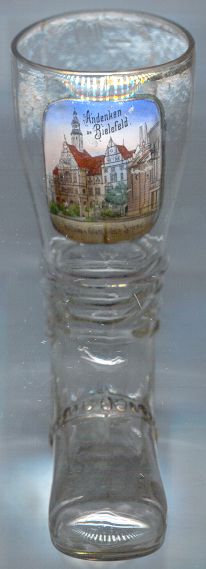

|
| DEUTSCHLAND | GERMANY |
| Bundesland: Nordrhein-Westfalen | North Rhine-Westphalia |
| Regierungsbezirk: Detmold | |
| Kreis: Bielefeld |

 Bielefeld is situated at an elevation of 113 m in East Westphalia. The area was first mentioned as Bylanuelde around 850.
The 'old town' (Biliuelde) was founded in 1214 by Count Hermann IV of Ravensberg at a crossroads of old trading routes in the vicinity
of a pass of the Teutoburger Wald mountains.
The castle Sparrenburg, first mentioned in 1256, became the administrative centre of the county of Ravensberg. During the late 13th century, the
'new town' below the castle started to develop. Both towns were united in 1520. Since 1346, Bielefeld belonged to the County Jülich and Berg.
From the end of the 16th century, cloth-making became the major economic factor for Bielefeld and it became known as the 'linnen town'.
In 1648, the county Ravensberg and the town Bielefeld came into possession of Brandenburg-Prussia and remained part of this state until 1947.
The industrial development of the town started with the opening in 1847 of the railway line from Cologne via Bielefeld to Minden.
During the following 50 years the population of Bielefeld grew rapidly. During World War II large parts of the historical old town were destroyed.
Today, Bielefeld is a thriving city with more than 300,000 inhabitants.
Bielefeld is situated at an elevation of 113 m in East Westphalia. The area was first mentioned as Bylanuelde around 850.
The 'old town' (Biliuelde) was founded in 1214 by Count Hermann IV of Ravensberg at a crossroads of old trading routes in the vicinity
of a pass of the Teutoburger Wald mountains.
The castle Sparrenburg, first mentioned in 1256, became the administrative centre of the county of Ravensberg. During the late 13th century, the
'new town' below the castle started to develop. Both towns were united in 1520. Since 1346, Bielefeld belonged to the County Jülich and Berg.
From the end of the 16th century, cloth-making became the major economic factor for Bielefeld and it became known as the 'linnen town'.
In 1648, the county Ravensberg and the town Bielefeld came into possession of Brandenburg-Prussia and remained part of this state until 1947.
The industrial development of the town started with the opening in 1847 of the railway line from Cologne via Bielefeld to Minden.
During the following 50 years the population of Bielefeld grew rapidly. During World War II large parts of the historical old town were destroyed.
Today, Bielefeld is a thriving city with more than 300,000 inhabitants.
The  old town hall (Altes Rathaus) [left, no. 3971: bottom picture left; and right,
no. 1065: centre left] was built in 1904 in Neo-Gothic and Neo-Renaissance style.
The belfry on the roof of the building was removed after World War II. A new town hall was built next to it in 1983.
old town hall (Altes Rathaus) [left, no. 3971: bottom picture left; and right,
no. 1065: centre left] was built in 1904 in Neo-Gothic and Neo-Renaissance style.
The belfry on the roof of the building was removed after World War II. A new town hall was built next to it in 1983.
The  municipal theatre (Stadttheater) [left, no. 3971: bottom picture right; and right,
no. 1065: right, barely visible] was built in 1902–1904 in Art Deco style
by the Berlin architect Bernhard Sehring. During World War II the theatre was heavily damaged by bombs in 1944. After the war the exterior
was restored to modified original plans while the interior was rebuilt according to modern plans. In 1960 the exterior was rebuilt by removing the
original details. These details were restored in 1977–1979 during an exterior restoration which followed the original plans. A major interior
rebuilding is scheduled for 2004–2006.
municipal theatre (Stadttheater) [left, no. 3971: bottom picture right; and right,
no. 1065: right, barely visible] was built in 1902–1904 in Art Deco style
by the Berlin architect Bernhard Sehring. During World War II the theatre was heavily damaged by bombs in 1944. After the war the exterior
was restored to modified original plans while the interior was rebuilt according to modern plans. In 1960 the exterior was rebuilt by removing the
original details. These details were restored in 1977–1979 during an exterior restoration which followed the original plans. A major interior
rebuilding is scheduled for 2004–2006.
The famous film director, Friedrich Wilhelm MURNAU (real name F. W. Plumpe) (1888–1931) was born in Bielefeld.
Murnau was one of the most important filmmakers of the first 30 years of film cinema. His films are considered "expressionist" for various characteristics.
Among them are: tormented characters, supernatural, nightmares, darkness, and psychology. Murnau's certainly most famous movie is
Nosferatu the Vampire. He died at a car crash in California eight days before the New York premiere of his last movie,
Tabu. His adopted name refers to the artists' colony Murnau in the Bavarian alps.
![[scale]](lineal.jpg)